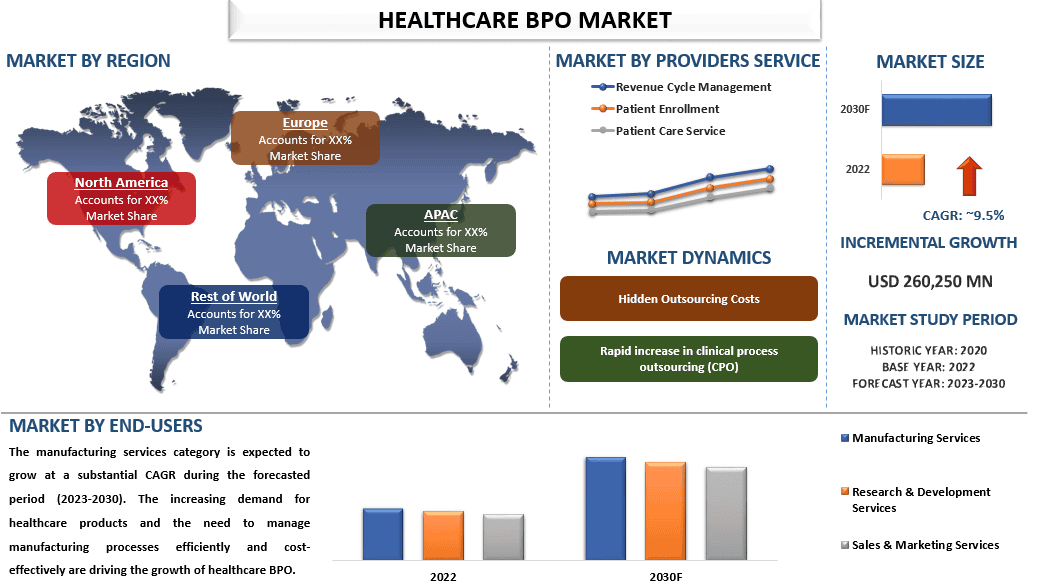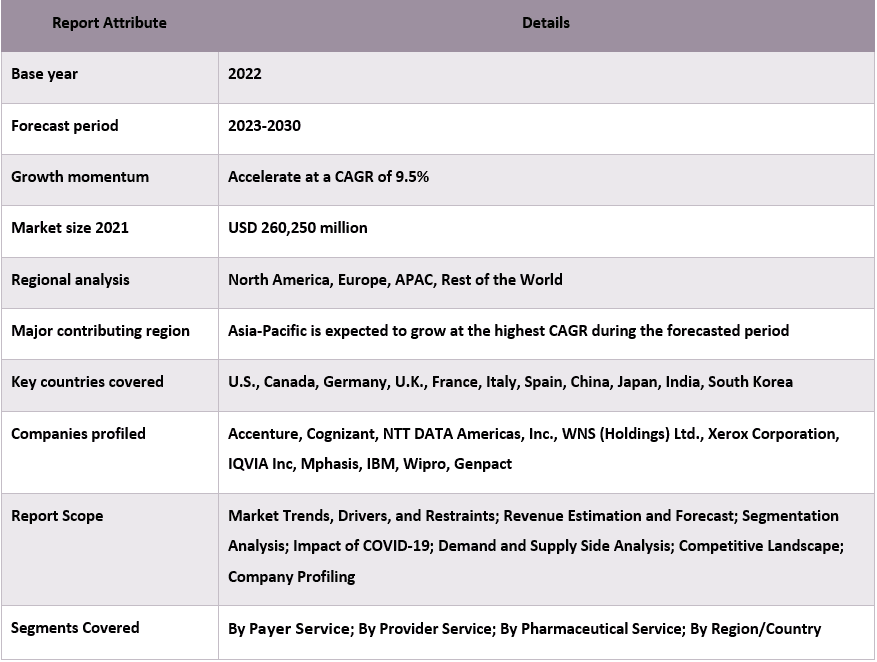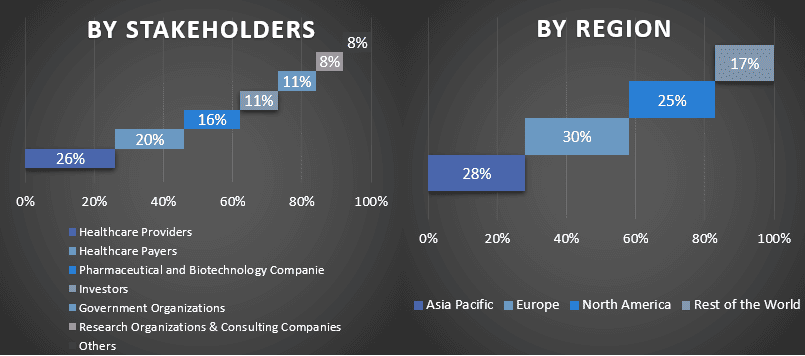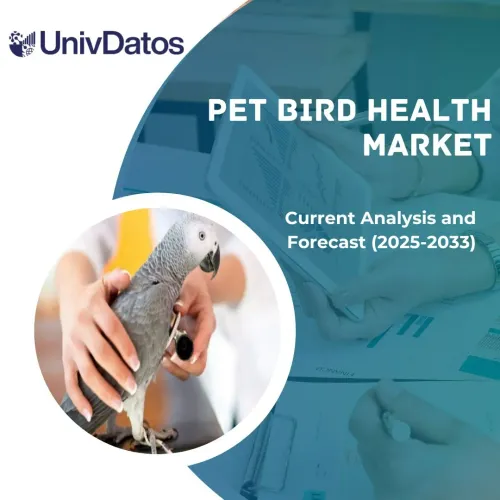- الرئيسية
- معلومات عنا
- صناعة
- الخدمات
- قراءة
- اتصل بنا
سوق خدمات الاستعانة بمصادر خارجية في مجال الرعاية الصحية: تحليل وتوقعات حالية (2022-2030)
التركيز على خدمة الدافع (إدارة الموارد البشرية، وإدارة المطالبات، وإدارة علاقات العملاء (CRM)، وإدارة علاقات العملاء (CRM)، والاستحواذ على تطوير المنتجات (PDBA)، وإدارة الرعاية، وإدارة مقدمي الخدمات، وغيرها)؛ خدمة مقدمي الخدمات (إدارة دورة الإيرادات، وتسجيل المرضى، وخدمة رعاية المرضى)؛ والخدمات الصيدلانية (خدمات التصنيع، وخدمات البحث والتطوير، وخدمات المبيعات والتسويق)؛ والمنطقة/البلد

تمتلك سوق خدمات الاستعانة بمصادر خارجية في مجال الرعاية الصحية قيمة 260,250 مليون دولار أمريكي في عام 2022 ومن المتوقع أن تنمو بمعدل نمو سنوي مركب قوي يبلغ حوالي 9.5٪ خلال الفترة المتوقعة (2023-2030) بسببالمبادرات الحكومية المتزايدة إلى جانب الطلب المتزايد على العمليات غير السريرية في صناعة الرعاية الصحية واعتماد التكنولوجيا في الرعاية الصحية يدفع نمو السوق في المنطقة.على سبيل المثال، في فبراير 2022، منحت فرع وزارة الصحة والخدمات الإنسانية ما يقرب من 55 مليون دولار أمريكي لـ 29 من مراكز الرفاهية التي تمولها إدارة خدمات الموارد البشرية لزيادة الوصول إلى الرعاية الصحية وجودتها للسكان المحرومين من خلال الرعاية الافتراضية.استفاد المرضى بشكل كبير من الرعاية الافتراضية، وخاصة خلال الوباء. ونتيجة لذلك، من المتوقع أن تدفع المبادرات الحكومية التوسع في السوق في البلاد.بالإضافة إلى ذلك، فإن الطلب المتزايد على خدمات الرعاية الصحية يرجع إلى عوامل مثل النمو السكاني، والشيخوخة السكانية، مما يؤدي إلى تطوير خدمات الاستعانة بمصادر خارجية في مجال الرعاية الصحية.على سبيل المثال، بحلول عام 2050، سيتضاعف إجمالي عدد الأفراد الذين تبلغ أعمارهم 60 عامًا وأكثر (2.1 مليار)، وفقًا لمنظمة الصحة العالمية، في عام 2022.كإضافة، يبحث المرضى عن الرعاية ومقدمي الخدمات الطبية ويحتاجون إلى إيجاد طرق للتعامل مع المسؤولية المتزايدة وتحسين الكفاءة.
يشمل بعض اللاعبين الرئيسيين العاملين في السوق Accenture و Cognizant و NTT DATA Americas, Inc. و WNS (Holdings) Ltd. و Xerox Corporation و IQVIA Inc و Mphasis و IBM و Wipro و Genpact. وقد قام العديد من عمليات الاندماج والاستحواذ إلى جانب الشراكات من قبل هؤلاء اللاعبين لتسهيل حصول العملاء على منتجات/تقنيات عالية التقنية ومبتكرة.
الرؤى المقدمة في التقرير
“من بين خدمات الدافع، يحتفظ قطاع إدارة الموارد البشرية بحصة كبيرة من السوق في عام 2022”
بناءً على خدمة الدافع، يتم تقسيم السوق إلى إدارة الموارد البشرية، وإدارة المطالبات، وإدارة علاقات العملاء (CRM)، والاستحواذ على تطوير المنتجات (PDBA)، وإدارة الرعاية، وإدارة مقدمي الخدمات، وغيرها. من بين هؤلاء، تحتفظ إدارة الموارد البشرية بحصة كبيرة من السوق. يتأثر توسع سوق خدمات الاستعانة بمصادر خارجية في مجال الرعاية الصحية بشدة بإدارة الموارد البشرية. تتطلب صناعة خدمات الاستعانة بمصادر خارجية في مجال الرعاية الصحية مجموعة كبيرة من المهنيين المهرة والمدربين الذين يمكنهم التعامل مع المهام غير السريرية لجمعيات الخدمات الطبية. هذا يذكر الخبراء بالمهارة للمناطق، على سبيل المثال، الترميز السريري، والتعامل مع المطالبات، ورعاية العملاء.
“من بين خدمات مقدمي الخدمات، احتفظ الألم المزمن بحصة كبيرة من السوق في عام 2022.”
بواسطة خدمة مقدمي الخدمات، يتم تقسيم السوق إلى إدارة دورة الإيرادات، وتسجيل المرضى، وخدمة رعاية المرضى. من بين هؤلاء، من المتوقع أن تنمو إدارة دورة الإيرادات بمعدل نمو سنوي مركب كبير خلال الفترة المتوقعة (2023-2030). RCM هو جزء أساسي من إدارة خدمات الاستعانة بمصادر خارجية في مجال الرعاية الصحية، ويلعب دورًا كبيرًا في قيادة تطوير سوق خدمات الاستعانة بمصادر خارجية في مجال الرعاية الصحية. يمكن أن تساعد الاستعانة بمصادر خارجية لـ RCM مؤسسات الرعاية الصحية في تحسين أدائها المالي ودعم نمو الصناعة من خلال توفير الخبرة والكفاءة في إدارة الجوانب المالية لخدمات الرعاية الصحية.
“منطقة آسيا والمحيط الهادئ لديها نمو كبير”
من المتوقع أن تنمو منطقة آسيا والمحيط الهادئ بمعدل نمو سنوي مركب كبير خلال الفترة المتوقعة نظرًا لأن سوق خدمات الاستعانة بمصادر خارجية في مجال الرعاية الصحية قد نما بشكل كبير بسبب الزيادة في الطلب على سوق خدمات الاستعانة بمصادر خارجية في مجال الرعاية الصحية في منطقة آسيا والمحيط الهادئ من المفترض أن تستفيد من القيادة الحكومية لزيادة نتائج الخدمات الطبية وتقليل التكاليف.على سبيل المثال، تهدف استراتيجية الرفاهية العامة للحكومة الهندية إلى تقديم خدمات رعاية صحية معقولة الجودة لجميع السكان، مما يتيح فرصًا جديدة لمؤسسات خدمات الاستعانة بمصادر خارجية في مجال الرعاية الصحية لتقديم خدمات، على سبيل المثال، الترميز السريري والتعامل مع المطالبات.
تغطية تقرير سوق خدمات الاستعانة بمصادر خارجية في مجال الرعاية الصحية

أسباب شراء هذا التقرير:
- تتضمن الدراسة تحديد حجم السوق وتحليل التنبؤات التي تم التحقق منها من قبل خبراء الصناعة الرئيسيين الموثقين.
- يقدم التقرير مراجعة سريعة للأداء العام للصناعة في لمحة.
- يغطي التقرير تحليلًا متعمقًا لنظرائه في الصناعة البارزين مع التركيز الأساسي على البيانات المالية التجارية الرئيسية ومحافظ المنتجات واستراتيجيات التوسع والتطورات الأخيرة.
- فحص مفصل للدوافع والقيود والاتجاهات الرئيسية والفرص السائدة في الصناعة.
- تغطي الدراسة السوق بشكل شامل عبر شرائح مختلفة.
- تحليل متعمق على المستوى الإقليمي للصناعة.
خيارات التخصيص:
يمكن تخصيص سوق خدمات الاستعانة بمصادر خارجية في مجال الرعاية الصحية العالمية بشكل أكبر حسب المتطلبات أو أي قطاع سوق آخر. إلى جانب ذلك، تدرك UMI أن لديك احتياجات عملك الخاصة، لذا لا تتردد في التواصل معنا للحصول على تقرير يناسب متطلباتك تمامًا.
جدول المحتويات
منهجية البحث لتحليل سوق خدمات الاستعانة بمصادر خارجية في مجال الرعاية الصحية (2022-2028)
كانت الخطوات الثلاث الرئيسية التي تم اتخاذها لإنشاء وتحليل اعتماد خدمات الاستعانة بمصادر خارجية في مجال الرعاية الصحية في المناطق الرئيسية على مستوى العالم هي تحليل السوق التاريخي، وتقدير السوق الحالي، والتنبؤ بالسوق المستقبلي لخدمات الاستعانة بمصادر خارجية في مجال الرعاية الصحية العالمية. تم إجراء بحث ثانوي شامل لجمع أرقام السوق التاريخية وتقدير حجم السوق الحالي. ثانيًا، للتحقق من صحة هذه الرؤى، تم أخذ العديد من النتائج والافتراضات في الاعتبار. علاوة على ذلك، أجريت أيضًا مقابلات أولية شاملة مع خبراء الصناعة عبر سلسلة قيمة سوق خدمات الاستعانة بمصادر خارجية في مجال الرعاية الصحية العالمية. بعد افتراض وصحة أرقام السوق من خلال المقابلات الأولية، استخدمنا نهجًا تصاعديًا/تنازليًا للتنبؤ بحجم السوق الكامل. بعد ذلك، تم اعتماد طرق تقسيم السوق وتثليث البيانات لتقدير وتحليل حجم السوق لقطاعات وشرائح الصناعة ذات الصلة. يتم شرح المنهجية التفصيلية أدناه:
تحليل حجم السوق التاريخي
الخطوة 1: دراسة متعمقة للمصادر الثانوية:
تم إجراء دراسة ثانوية تفصيلية للحصول على حجم السوق التاريخي لخدمات الاستعانة بمصادر خارجية في مجال الرعاية الصحية من خلال مصادر داخلية للشركة مثلالتقارير السنوية والبيانات المالية وعروض الأداء والبيانات الصحفية وما إلى ذلك،والمصادر الخارجية بما في ذلكالمجلات والأخبار والمقالات والمنشورات الحكومية ومنشورات المنافسين وتقارير القطاعات وقاعدة بيانات الطرف الثالث والمنشورات الموثوقة الأخرى.
الخطوة 2: تقسيم السوق:
بعد الحصول على حجم السوق التاريخي لخدمات الاستعانة بمصادر خارجية في مجال الرعاية الصحية، أجرينا تحليلًا ثانويًا تفصيليًا لجمع رؤى وحصص السوق التاريخية لشرائح وشرائح فرعية مختلفة للمناطق الرئيسية. يتم تضمين الشرائح الرئيسية في التقرير كخدمة الدافع، وخدمة مقدمي الخدمات، والخدمات الصيدلانية. علاوة على ذلك، تم إجراء تحليلات على مستوى الدولة لتقييم الاعتماد العام لنماذج الاختبار في تلك المنطقة.
الخطوة 3: تحليل العوامل:
بعد الحصول على حجم السوق التاريخي للشرائح والشرائح الفرعية المختلفة، أجريناتحليل العوامللتقدير حجم السوق الحالي لخدمات الاستعانة بمصادر خارجية في مجال الرعاية الصحية. علاوة على ذلك، أجرينا تحليلًا للعوامل باستخدام متغيرات تابعة ومستقلة مثل خدمة الدافع، وخدمة مقدمي الخدمات، والخدمات الصيدلانية لسوق خدمات الاستعانة بمصادر خارجية في مجال الرعاية الصحية. تم إجراء تحليل شامل لسيناريوهات العرض والطلب مع الأخذ في الاعتبار الشراكات الكبرى وعمليات الاندماج والاستحواذ والتوسع في الأعمال وإطلاق المنتجات في قطاع سوق خدمات الاستعانة بمصادر خارجية في مجال الرعاية الصحية في جميع أنحاء العالم.
تقدير وتوقع حجم السوق الحالي
تحديد حجم السوق الحالي:بناءً على رؤى قابلة للتنفيذ من الخطوات الثلاث المذكورة أعلاه، توصلنا إلى حجم السوق الحالي واللاعبين الرئيسيين في سوق خدمات الاستعانة بمصادر خارجية في مجال الرعاية الصحية العالمية وحصص السوق للشرائح. تم تحديد جميع تقسيمات حصص النسب المئوية المطلوبة وتقسيمات السوق باستخدام النهج الثانوي المذكور أعلاه وتم التحقق منها من خلال المقابلات الأولية.
التقدير والتنبؤ:لتقدير السوق والتنبؤ به، تم تخصيص أوزان لعوامل مختلفة بما في ذلك المحركات والاتجاهات والقيود والفرص المتاحة لأصحاب المصلحة. بعد تحليل هذه العوامل، تم تطبيق تقنيات التنبؤ ذات الصلة، أي نهج من أعلى إلى أسفل / من أسفل إلى أعلى، للوصول إلى توقعات السوق لعام 2028 لقطاعات وشرائح فرعية مختلفة عبر الأسواق الرئيسية على مستوى العالم. تشمل منهجية البحث المعتمدة لتقدير حجم السوق:
- حجم السوق للصناعة، من حيث الإيرادات (دولار أمريكي) ومعدل اعتماد سوق الاستعانة بمصادر خارجية للرعاية الصحية عبر الأسواق الرئيسية محليًا
- جميع النسب المئوية، والانقسامات، وتفصيلات شرائح السوق والشرائح الفرعية
- اللاعبين الرئيسيين في سوق الاستعانة بمصادر خارجية للرعاية الصحية العالمية من حيث المنتجات المعروضة. أيضًا، استراتيجيات النمو التي يتبناها هؤلاء اللاعبون للتنافس في السوق المتنامية بسرعة
التحقق من حجم السوق وحصتها
البحث الأساسي:أُجريت مقابلات متعمقة مع قادة الرأي الرئيسيين (KOLs) بما في ذلك كبار المسؤولين التنفيذيين (CXO / VPs، ورئيس المبيعات، ورئيس التسويق، والرئيس التشغيلي، والرئيس الإقليمي، ورئيس الدولة، وما إلى ذلك) عبر المناطق الرئيسية. ثم تم تلخيص نتائج الأبحاث الأولية، وإجراء تحليل إحصائي لإثبات الفرضية المذكورة. تم دمج المدخلات من الأبحاث الأولية مع النتائج الثانوية، وبالتالي تحويل المعلومات إلى رؤى قابلة للتنفيذ.
تقسيم المشاركين الأساسيين في مناطق مختلفة

هندسة السوق
تم توظيف تقنية التثليث البياني لإكمال التقدير العام للسوق والوصول إلى أرقام إحصائية دقيقة لكل قطاع وشريحة فرعية من سوق الاستعانة بمصادر خارجية للرعاية الصحية العالمية. تم تقسيم البيانات إلى عدة قطاعات وشرائح فرعية بعد دراسة معلمات واتجاهات مختلفة في مجالات خدمات الدافع، وخدمات المزود، والخدمات الصيدلانية في سوق الاستعانة بمصادر خارجية للرعاية الصحية العالمية.
الهدف الرئيسي من دراسة سوق الاستعانة بمصادر خارجية للرعاية الصحية العالمية
تم تحديد اتجاهات السوق الحالية والمستقبلية لسوق الاستعانة بمصادر خارجية للرعاية الصحية العالمية في الدراسة. يمكن للمستثمرين الحصول على رؤى استراتيجية لبناء تقديرهم للاستثمارات على التحليل النوعي والكمي الذي تم إجراؤه في الدراسة. حددت اتجاهات السوق الحالية والمستقبلية جاذبية السوق الإجمالية على المستوى الإقليمي، مما يوفر منصة للمشارك الصناعي لاستغلال السوق غير المستغلة للاستفادة من ميزة المحرك الأول. تشمل الأهداف الكمية الأخرى للدراسات:
- تحليل حجم السوق الحالي والمتوقع لسوق الاستعانة بمصادر خارجية للرعاية الصحية من حيث القيمة (بالدولار الأمريكي). أيضًا، تحليل حجم السوق الحالي والمتوقع للقطاعات والشرائح الفرعية المختلفة
- تشمل القطاعات في الدراسة مجالات خدمة الدافع، وخدمة المزود، والخدمات الصيدلانية
- تعريف وتحليل الإطار التنظيمي لصناعة الاستعانة بمصادر خارجية للرعاية الصحية
- تحليل سلسلة القيمة المتضمنة مع وجود وسطاء مختلفين، إلى جانب تحليل سلوكيات العملاء والمنافسين في الصناعة
- تحليل حجم السوق الحالي والمتوقع لسوق الاستعانة بمصادر خارجية للرعاية الصحية للمنطقة الرئيسية
- تشمل البلدان الرئيسية للمناطق التي تمت دراستها في التقرير آسيا والمحيط الهادئ وأوروبا وأمريكا الشمالية وبقية العالم
- ملفات تعريف الشركات في سوق الاستعانة بمصادر خارجية للرعاية الصحية واستراتيجيات النمو التي يتبناها اللاعبون في السوق للحفاظ على استمرارهم في السوق المتنامية بسرعة
- تحليل متعمق على المستوى الإقليمي للصناعة
ذات صلة التقارير
العملاء الذين اشتروا هذا المنتج اشتروا أيضًا










